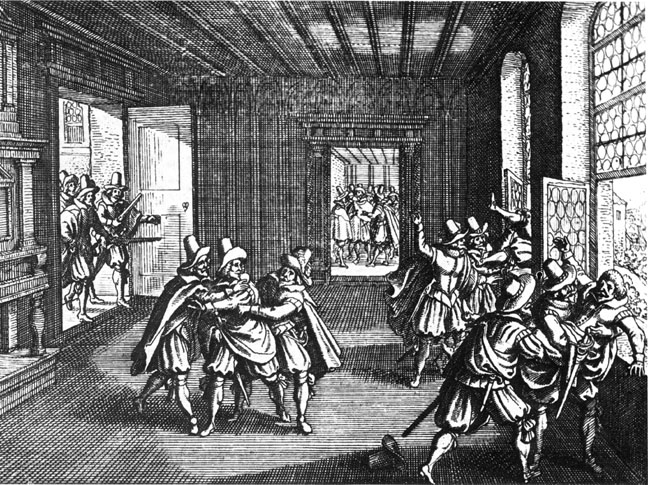The Defenestration of Prague, 1618
 |
| 17th Century woodcut depicting the defenestration |
As it turns out, defenestration is the act of throwing someone out a window. It comes from the Latin: de, out of, with a downward motion implied, and fenestra, window. It's really quite literal. There is also a secondary meaning of a swift dismissal or expulsion, as from office or a political position. If you've been reading my blog on a regular basis, you probably know me well enough to know that I wouldn't be writing this if the action in Prague was a metaphorical type of defenestration.
The second thing that caught my attention is that the 1618 Defenestration is actually the Second Defenestration of Prague. You've just gotta love a city that makes a habit out of throwing people out of windows.
 |
| Jan Hus |
Hus's followers were known as the Hussites. On July 30, 1419, a procession led by the priest Jan Zelivsky made its way along the streets of Prague to the Town Hall. Along the way, someone threw a stone at Zelivsky from a window of the Town Hall. This enraged the crowd and the Hussites stormed the building. They threw the judge, the burgermeister, and 13 members of the town council out the window. Those who were not killed in the fall were killed by the mob.
 |
| King Wenceslaus |
This brings us to the Second Defenestration of Prague. It had been nearly 200 years since the First Defenestration. At this time, the region was still operating under the rules established by the Peace of Augsburg in 1555. When the Peace was established, there were 255 German states in the Holy Roman Empire. The ruler of each state was allowed to establish the religion of his people (Lutheranism or Catholicism.) As you can imagine, tempers were short.
In 1617, some Catholic officials had ordered a stop to the building of some Protestant churches. The Catholics claimed the land belonged to them. The Lutherans claimed it belonged to the King, who could do with it as he chose. They also feared that it was just the beginning of acts by the Holy Roman Emperor against the Protestants.
On May 23, 1618, a mob of Protestants stormed Prague Castle, where a meeting of the four Regents was taking place. According to several sources, the mob gained admittance by paying bribes, "in the usual manner." [Which brings me to the third reason I love this story: not only does Prague have such a rich history of defenestrations that it has to number them, but there's apparently a protocol to the process.] Two of the Regents were excused, but the other two, Count Vilem Slavata and Count Jarolslaw Martinitz, were at the mercy of the crowd.
 |
| Count Slavata: didn't go quietly |
Apparently, she did. According to witnesses -- Catholic, of course -- a band of angels intercepted them and bore them safely to the ground. More pragmatic viewers said that they had landed on a pile of manure that had been left behind by gardeners. The men scurried away to safety. Later, Fabricius, the secretary, was made a noble by the Emperor: Baron von Hohenfall, or "Baron of Highfall."
The Second Defenestration was the beginning of the Bohemian Revolt, which in turn led to the Thirty Years War. Initially, it was a war for religious freedom, but quickly escalated into a struggle for power among most of the European powers. By the time it was finished, most of the major powers had been bankrupted, and the population and land of the German states suffered a great deal.
No comments:
Post a Comment